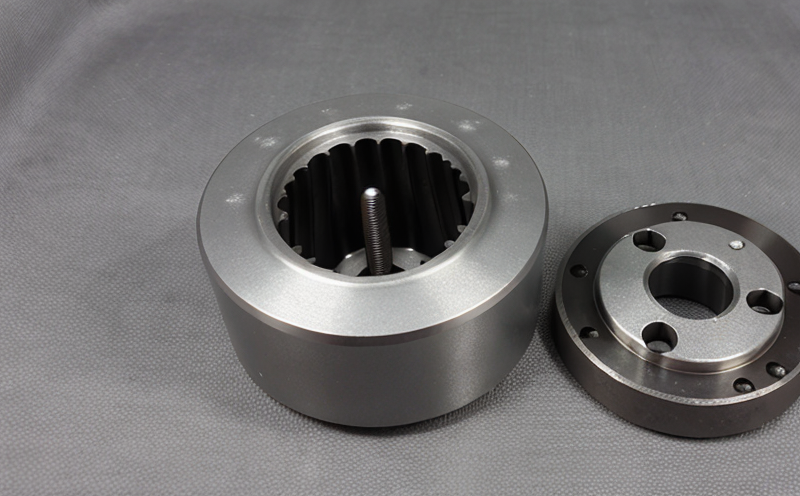ASTM E9 Compression Testing of AM Metallic Materials
The ASTM E9 standard specifies the procedure for conducting compression testing on metallic materials. This test is particularly valuable in powder metallurgy and additive manufacturing (AM) sectors where the mechanical properties of metals, especially under high stress conditions, are critical to product performance. In these industries, understanding how AM-produced parts behave under load helps ensure they meet safety and performance standards.
The ASTM E9 compression test evaluates the compressive strength, yield strength, and strain rate sensitivity of metallic materials. It is a destructive testing method that involves applying axial compressive forces to a cylindrical specimen until failure occurs. The specimen's dimensions are typically 10 mm in diameter by 25 mm in height for standard tests.
For AM metallic materials, this test is crucial because the manufacturing process can introduce unique microstructural and mechanical properties compared to conventionally produced metals. By using ASTM E9, manufacturers can validate that their products meet specified strength requirements and are suitable for various applications, such as aerospace components or automotive parts.
The testing procedure involves several critical steps:
- Specimen preparation: Ensuring the specimen is free from defects, properly oriented, and machined to standard dimensions.
- Mounting the specimen in a compression testing machine equipped with appropriate fixtures.
- Applying a controlled load at a specified rate until failure occurs. The load application rate must be within defined limits, typically 0.2 mm/s or as specified by the user.
The test results provide valuable insights into the metallurgical properties of AM materials, including grain structure and porosity levels, which can affect mechanical performance. The data generated from ASTM E9 tests helps quality managers, R&D engineers, and compliance officers make informed decisions regarding material selection, process optimization, and product design.
| Specimen Type | Load Application Rate (mm/s) | Standard Diameter (mm) | Standard Height (mm) |
|---|---|---|---|
| Cylindrical | 0.2 mm/s | 10 mm | 25 mm |
The ASTM E9 standard ensures consistency and reliability in testing, which is essential for regulatory compliance and quality assurance.
Why Choose This Test
Selecting the appropriate compression test method is crucial to ensure accurate results that reflect material behavior under stress. ASTM E9 offers several advantages over other testing methods:
- High Precision: The standard provides detailed instructions for specimen preparation and load application, ensuring consistent results.
- Regulatory Compliance: ASTM E9 is widely recognized in industries where regulatory oversight is stringent.
- Compatibility with AM Processes: This test method can effectively evaluate materials produced through powder metallurgy and AM processes, which may have unique properties compared to conventionally manufactured parts.
The results from ASTM E9 tests are vital for quality assurance teams. They help identify potential issues in the manufacturing process and ensure that the final product meets specified mechanical performance criteria.
International Acceptance and Recognition
The ASTM E9 standard is well-established and widely accepted globally. It aligns with international standards such as ISO, EN, and IEC, ensuring that the results from these tests are comparable across different regions and industries.
In the powder metallurgy sector, where materials need to withstand high stresses in applications like automotive and aerospace components, ASTM E9 provides a robust framework for evaluating compressive strength and yield strength. In additive manufacturing, this test is essential for assessing the integrity of parts produced through processes such as laser sintering or electron beam melting.
By adhering to ASTM E9 standards, manufacturers can ensure that their products meet stringent quality control requirements. This consistency in testing methods also facilitates collaboration between suppliers and end-users, enhancing trust and reliability within supply chains.
Use Cases and Application Examples
| Application | Description |
|---|---|
| Aerospace Components | Evaluating the compressive strength of metallic components used in aircraft engines and landing gear. |
| Automotive Parts | Assessing the durability of engine blocks, brake pads, and other critical components under high stress conditions. |
| Biomaterials | Determining the mechanical properties of implants used in orthopedic surgeries to ensure patient safety. |
| Defense Applications | Evaluating the resilience of armor plating and other defense-related components under extreme conditions. |
The ASTM E9 test is particularly useful in these applications because it provides precise data on how AM-produced materials behave under compressive loads. This information is critical for ensuring that the final products are reliable and safe for use in demanding environments.





